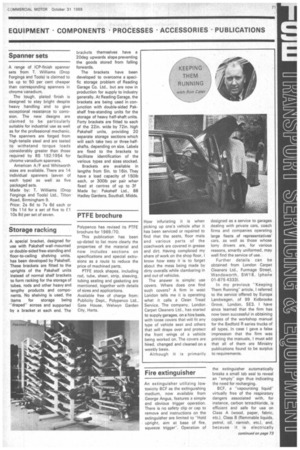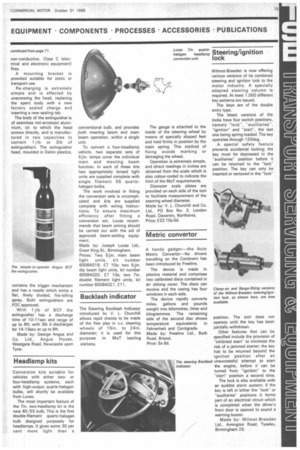Fire extinguisher
Page 73

Page 75

If you've noticed an error in this article please click here to report it so we can fix it.
An extinguisher utilizing low toxicity BCF as the extinguishing medium, now available from George Angus, features a simple and obvious trigger operation. There is no safety clip or cap to remove and instructions on the extinguisher are limited to "Hold upright, aim at base of fire, squeeze trigger". Operation of the extinguisher automatically breaks a small tab seal to reveal an "empty" sign thus indicating the need for recharging.
BCF, a "vapourizing liquid" virtually free of the respiratory dangers associated with, for instance, carbon tetrachloride, is efficient and safe for use on Class A (wood, paper, fabric, etc.), Class B (flammable liquids, petrol, oil, varnish, etc.), and, because it is electrically non-conductive, Class C lelectrical and electronic equipment} fires.
A mounting bracket is provided suitable for static or transport use.
Re-charging is extremely simple and is effected by unscrewing the head, replacing the spent body with a new factory sealed charge and inserting a new sealing tab.
The body of the extinguisher is of seamless red-anodized aluminium, on to which the head screws directly, and is manufactured in two capacities to contain 1lb or 3Ib of extinguishant. The extinguisher head, moulded in Delrin plastics, contains the trigger mechanism and has a nozzle which emits a flat, finely divided, fire-killing spray. Both extinguishers are FOC approved.
With 1 lb of BCF the extinguisher has a discharge time of 10-11sec and range of up to 6ft; with 3Ib it discharges for 14-15sec at up to 6ft.
Made by: George Angus and Co. Ltd., Angus House, Westgate Road, Newcastle upon Tyne.


























































































































